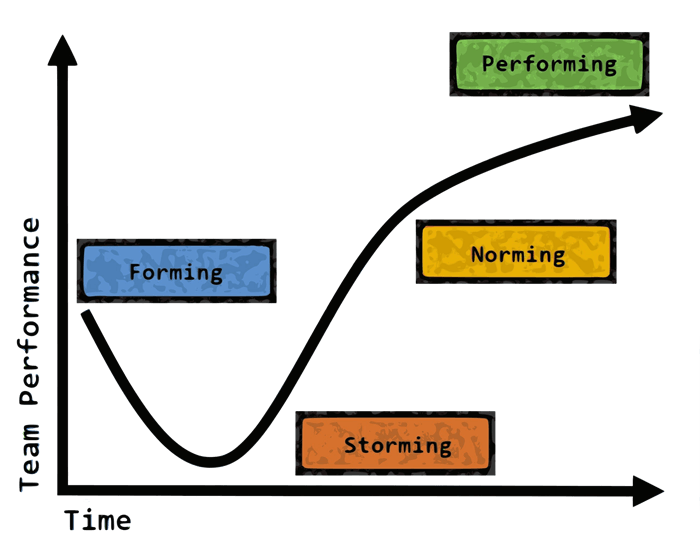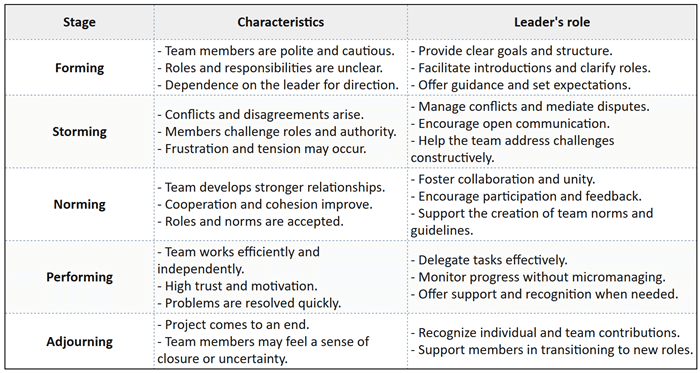Understanding 5 stages of group development and how you should perform throughout the process

Imagine you're leading a new team on a substantial project. Despite their expertise, the group seems hesitant, unsure of roles, and slow to collaborate. Recognizing that the team is in the "Forming" stage of development, you can provide clear direction and foster teamwork to set them on the right path.
This highlights the importance of understanding group development stages. Knowing where your team stands allows you to adapt your leadership to meet their needs, driving collaboration and success. This article will dive into these stages and their role in building effective teams.
What are the stages of group development?
Psychologist Bruce Tuckman first introduced the stages of group development (also called team development or team formation) in his 1965 essay, "Developmental Sequence in Small Groups." The essay outlines how team members, initially strangers, move through five distinct stages before becoming a cohesive, high-performing unit.
The five stages are: Forming, Storming, Norming, Performing, and Adjourning.
Tuckman’s model has since become a foundational tool for understanding group dynamics. It offers valuable insights for team leaders to recognize how relationships evolve throughout a project. By understanding these five stages, leaders can better support their teams, fostering collaboration and efficiency from the early stages of group formation.
Why is it important to understand your team development stages?
Understanding the stage of group development your team is in can significantly enhance productivity and collaboration. By recognizing which phase the group is experiencing, leaders can provide the appropriate guidance and support to navigate challenges and capitalize on opportunities.
For instance, knowing that conflict is natural in the Storming phase helps leaders manage disputes effectively and prevent the team from becoming derailed. In contrast, in the Performing stage, understanding that the team is self-sufficient allows leaders to delegate more confidently and focus on strategic tasks.
Moreover, awareness of the group’s development stage allows for better communication and expectation management. Teams in the early stages may need more structure, direction, and reassurance, while those in later stages benefit from autonomy and trust.
This insight ensures that team members are adequately utilized, fostering a work environment conducive to individual growth and collective success. Ultimately, understanding these stages helps leaders build stronger, more cohesive teams capable of sustained high performance.

Tuckman's 5 stages of team development
The stages of group development are typically described by Dr. Bruce Tuckman’s model, which outlines five distinct phases that teams go through as they form and evolve. These stages are:
Stage 1 – Forming
This is the stage where the team is established, and members begin to get acquainted and learn about each other for the task ahead.
At this point, some members may not fully grasp the team’s common goals or their specific individual responsibilities. The general mindset of the team members during this stage includes:
- Making decisions based on consensus and minimizing conflict as everyone is still getting familiar with one another
- Feeling excited and enthusiastic about the new challenge
- Observing and assessing other team members closely
- Defining their role within the team structure
During this stage, the team leader must play a robust guiding role, clearly communicating the team’s goals and outlining each member’s responsibilities.
As collaboration progresses, team members express their opinions and might challenge the initial rules, leading the team into the next stage.
Stage 2 – Storming
In this stage, differing opinions on work styles, behavior, and problem-solving approaches can lead to conflicts and disagreements among team members. This is often seen as the most turbulent stage and can result in undesirable outcomes.
Members may begin to question and attempt to change or break the established rules. Worse, some individuals might show non-cooperative attitudes or dissatisfaction with the current working method, while others may feel stressed and distracted.
However, if viewed from a positive perspective, this is the time when members begin to understand each other better. The key during this stage is for the entire group to face the situation together and move swiftly toward the next stage.
Stage 3 – Norming
This stage occurs when team members accept differences, recognize each other's strengths, and show greater respect for one another.
Communication becomes more fluid, with members consulting each other and seeking help when needed. New working rules are often established to minimize unnecessary conflict and debate.
It's important to note that the Norming stage can sometimes overlap with the Storming stage, especially when new challenges, targets, or conflicts arise. Team performance improves significantly during this stage as the group focuses more on their collective goals.
Once most conflicts are resolved, the team moves on to the fourth stage.
Stage 4 – Performing
At this stage, the team reaches its highest level of performance and relies less on supervision. This is the result of overcoming challenges from the previous stages. While discussions still occur, any issues are quickly and efficiently resolved.
Members work with a relaxed mindset and a heightened sense of teamwork. Even if the number of team members changes, overall performance remains steady.
Stage 5 – Adjourning
This final stage, added later by Tuckman, occurs when the project is completed and the team disbands. Members reflect on their achievements and may experience feelings of closure or loss as they move on to new assignments or roles.
In the Adjourning stage, as the project wraps up, the leader’s focus shifts to facilitating a smooth transition. This involves ensuring proper closure, reflecting on the team’s accomplishments, and recognizing individual contributions.
These five stages are not always linear, and teams may move back and forth between phases, especially as new challenges or members are introduced.
Leaders' role during 5 stages of group development
Each stage of team development requires a unique leadership approach to address the evolving dynamics within the group. In Forming, leaders provide guidance and build relationships, while in Storming, they mediate conflicts. As teams reach Norming and Performing, leaders focus on collaboration and delegation.

Help your team move quickly to the Performing stage
Every leader aims to see their team reach the Performing stage, where the team operates at peak efficiency with minimal supervision. But how can this be achieved?
Leaders must adapt their approach to each phase of team development, addressing conflicts head-on and fostering an environment of open communication. By facilitating collaboration, reinforcing positive interactions, and ensuring clear goals and roles, leaders can guide their teams through challenges more smoothly. This proactive approach helps the team progress quickly toward the Performing stage, where they can work independently and at their highest potential.

Tara Minh
Operation Enthusiast
On this page
- What are the stages of group development?
- Why is it important to understand your team development stages?
- Tuckman's 5 stages of team development
- Stage 1 – Forming
- Stage 2 – Storming
- Stage 3 – Norming
- Stage 4 – Performing
- Stage 5 – Adjourning
- Leaders' role during 5 stages of group development
- Help your team move quickly to the Performing stage